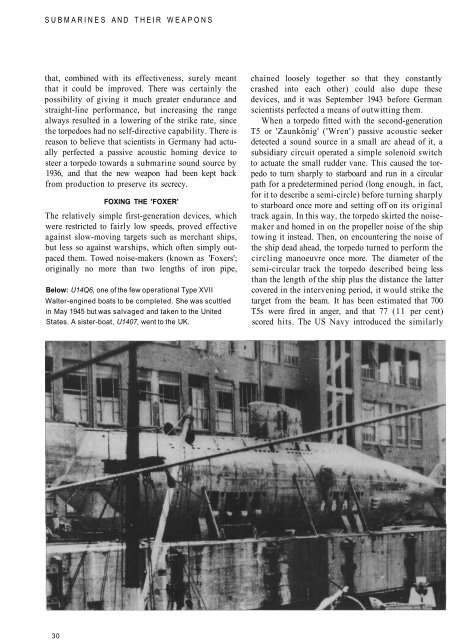Submarines and their Weapons - Aircraft of World War II
Submarines and their Weapons - Aircraft of World War II
Submarines and their Weapons - Aircraft of World War II
Create successful ePaper yourself
Turn your PDF publications into a flip-book with our unique Google optimized e-Paper software.
SUBMARINES AND THEIR WEAPONS<br />
that, combined with its effectiveness, surely meant<br />
that it could be improved. There was certainly the<br />
possibility <strong>of</strong> giving it much greater endurance <strong>and</strong><br />
straight-line performance, but increasing the range<br />
always resulted in a lowering <strong>of</strong> the strike rate, since<br />
the torpedoes had no self-directive capability. There is<br />
reason to believe that scientists in Germany had actually<br />
perfected a passive acoustic homing device to<br />
steer a torpedo towards a submarine sound source by<br />
1936, <strong>and</strong> that the new weapon had been kept back<br />
from production to preserve its secrecy.<br />
FOXING THE 'FOXER'<br />
The relatively simple first-generation devices, which<br />
were restricted to fairly low speeds, proved effective<br />
against slow-moving targets such as merchant ships,<br />
but less so against warships, which <strong>of</strong>ten simply outpaced<br />
them. Towed noise-makers (known as 'Foxers';<br />
originally no more than two lengths <strong>of</strong> iron pipe,<br />
Below: U14Q6, one <strong>of</strong> the few operational Type XV<strong>II</strong><br />
Walter-engined boats to be completed. She was scuttled<br />
in May 1945 but was salvaged <strong>and</strong> taken to the United<br />
States. A sister-boat, U1407, went to the UK.<br />
30<br />
chained loosely together so that they constantly<br />
crashed into each other) could also dupe these<br />
devices, <strong>and</strong> it was September 1943 before German<br />
scientists perfected a means <strong>of</strong> outwitting them.<br />
When a torpedo fitted with the second-generation<br />
T5 or 'Zaunkönig' ('Wren') passive acoustic seeker<br />
detected a sound source in a small arc ahead <strong>of</strong> it, a<br />
subsidiary circuit operated a simple solenoid switch<br />
to actuate the small rudder vane. This caused the torpedo<br />
to turn sharply to starboard <strong>and</strong> run in a circular<br />
path for a predetermined period (long enough, in fact,<br />
for it to describe a semi-circle) before turning sharply<br />
to starboard once more <strong>and</strong> setting <strong>of</strong>f on its original<br />
track again. In this way, the torpedo skirted the noisemaker<br />
<strong>and</strong> homed in on the propeller noise <strong>of</strong> the ship<br />
towing it instead. Then, on encountering the noise <strong>of</strong><br />
the ship dead ahead, the torpedo turned to perform the<br />
circling manoeuvre once more. The diameter <strong>of</strong> the<br />
semi-circular track the torpedo described being less<br />
than the length <strong>of</strong> the ship plus the distance the latter<br />
covered in the intervening period, it would strike the<br />
target from the beam. It has been estimated that 700<br />
T5s were fired in anger, <strong>and</strong> that 77 (11 per cent)<br />
scored hits. The US Navy introduced the similarly


